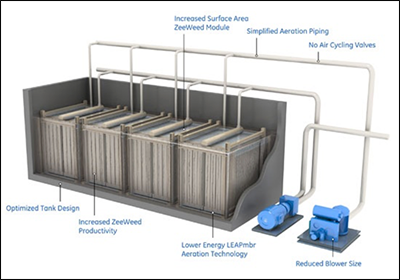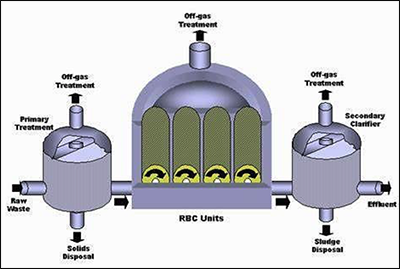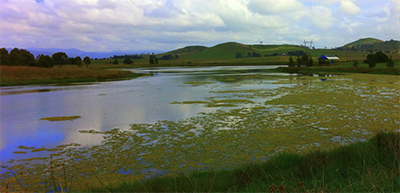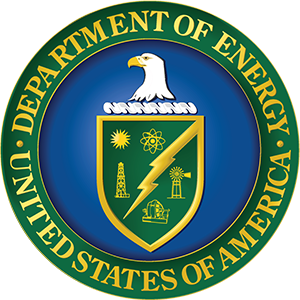Introduction
Within This Page
Wastewater treatment refers to the physical, chemical, and biological processes used to remove pollutants from wastewater before discharging it into a waterbody. Facilities are designed to ensure effluent will not adversely affect the receiving waterbodies and meet the requirements of the National Pollution Discharge Elimination System (NPDES) permits. The primary materials requiring treatment in domestic wastewater are organic matter, nitrogen and phosphorus. Treatment processes can take many forms depending on community needs and resources. Treatment at a Water Resource Recovery Facility (WRRF) usually consists of pretreatment, followed by primary and secondary treatment, and additional advanced processes if resources are being recovered.
Pretreatment can consist of removal of bulky matter with screens or grinders, removal of grit and other solids to improve downline processes and protect pipelines and equipment, and if required, removal of fat, oil and grease. Primary treatment is usually accomplished with sedimentation and clarification equipment to separate settleable and floating matter from the water using physical and chemical methods. Primary treatment reduces the total suspended solids (TSS), chemical oxygen demand (COD), and biological oxygen demand (BOD). Secondary treatment uses biological processes to further reduce solids in the effluent. Bacteria feed on organic matter; the excess sludge is removed to be made into biosolids and the water goes through secondary clarification, followed by disinfection. Advanced treatment includes processes to dewater the sludge and reduce pathogens, and treat the water to meet regulatory limits before reuse or discharge.
Description
Membrane Reactors
Membrane reactors use a permeable membrane combined with a chemical or biological process to perform a separation and reaction in the same vessel. In wastewater treatment, membrane bioreactors are common, combining a membrane like microfiltration or ultrafiltration with a biological wastewater treatment process like activated sludge. The membrane effectively removes solids and microorganisms while the activated sludge process treats the wastewater, producing clean water and solids for further treatment before discharge. There are several important considerations such as fouling, proper mixing and biological performance which must be considered when implementing a membrane bioreactor.

Membrane reactor diagram
Image Credit: American Membrane Technology Association
Decentralized SystemsDownload mou-intro-paper-081712-pdf-adobe-acrobat-pro.pdf
Decentralized systems implement wastewater treatment at the source for individual dwellings or facilities, groups of homes or businesses, and entire communities. Installed at or near the source of the wastewater, treatment options can range from simple, passive systems such as septic or onsite systems to more complex systems that collect and treat the wastewater before expulsion to surface waters. Depending on the community, decentralized systems can be cost-effective, green and sustainable.
Biological Reactors
Biological wastewater treatment relies on microorganisms in biological reactors to treat wastewater. As these microorganisms assimilate organic matter and nutrients present in the wastewater for their growth, they are simultaneously removing these components from the wastewater. Once removed, the microorganisms (known now as biomass) can then be removed as solids, leaving a liquid portion which can be further treated to clean water. Biological reactors can be aerobic or anaerobic depending on the design of the water resource recovery facility.

Biological reactor diagram
EPA Nutrient Removal
Nitrogen and phosphorus are the primary causes of adverse environmental impacts such as eutrophication, resulting in algal blooms, fish kills, and the deterioration of water bodies. To combat this issue, water resource recovery facilities implement nutrient removal technologies before discharging effluent to water bodies. There are a variety of nitrogen and phosphorus removal technologies available that are either physical, chemical, biological or a combination. Solutions vary depending on size and configuration of the water resource recovery facility and nitrogen and phosphorus removal demands.

Algae blooms on a lake
Relevant Codes and Standards
- UFC 3-240-01 Wastewater Treatment and Collection
- UFGS 46 07 53 Packaged Wastewater Treatment EquipmentDownload UFGS%2046%2007%2053.pdf
- UFGS 46 25 14 Coalescing [Or Vertical Tube] Oil-Water SeparatorsDownload UFGS%2046%2025%2014.pdf
- UFGS 46 23 00 Grit Removal Equipment
- UFGS 46 43 21 Circular Clarifier Equipment
Additional Resources
Publications
Water Environment Federation
- Aeration DesignDownload wsec-2017-fs-024-mrrdc-lsf-aeration-design_final.pdf
- BlowersDownload wsec-2017-fs-025-mrrdc-lsf-blowers_final.pdf
- DiffusersDownload wsec-2017-fs-026-mrrdc-lsf-diffusers_final.pdf
- Grit RemovalDownload wsec-2017-fs-021-mrrdc-lsf-grit-removal_final.pdf
- Odor Management and ControlDownload wsec-2017-fs-028-liquid-stream-fundamentals--odor-control_final.pdf
- ScreeningDownload wsec-2017-fs-020-mrrdc-lsf-screening_final.pdf
- SedimentationDownload wsec-2017-fs-022-liquid-stream-fundamentals--clarification-sedimentation_final.pdf
- Tertiary FiltrationDownload wsec-2017-fs-027-mrrdc-lsf-filtration_final.pdf
- Whole Plant ModelingDownload wsec-2017-fs-023-mrrdc-lsf-whole-plant-modeling_final.pdf










